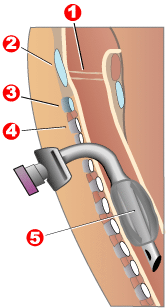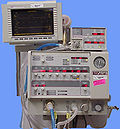Tracheotomy

1 - Vocal cords
2 - Thyroid cartilage
3 - Cricoid cartilage
4 - Tracheal cartilages
5 - Balloon cuff
Tracheotomy and tracheostomy is a surgery on the neck to open a direct path by cutting a hole in the trachea (windpipe). They are performed by paramedics, veterinarians, emergency physicians, and surgeons. Both surgical and percutaneous techniques are now widely used.
Tracheostomy was written about in ancient Egyptian tablets,[1] but, in the 12th century, Ibn Zuhr described the first correct tracheotomy operation for people who were suffocating (could not breathe).[2] The current tracheostomy was described in 1909 by Chevalier Jackson, an American doctor.
Tracheotomy Media
Tracheotomy tubes and endotracheal tubes are often attached to ventilators to assist in breathing.
Hieronymus Fabricius (1533–1619) was the first to introduce the idea of a tracheostomy tube
References
- ↑ "Tracheostomy: Evolution of an Airway," Archived 2017-04-01 at the Wayback Machine Steven E. Sittig and James E. Pringnitz, AARC Times, February 2001.
- ↑ Prof. Dr. Mostafa Shehata, "The Ear, Nose and Throat in Islamic Medicine", Journal of the International Society for the History of Islamic Medicine, 2003 (1): 2-5 [4].
Other websites
- Tracheotomy Info
- Aaron's tracheostomy page
- How to perform an emergency tracheotomy Archived 2007-12-24 at the Wayback Machine (for information purposes only)
- RT Corner Educational Site for RT's and Nurses Archived 2017-09-24 at the Wayback Machine
- Pictures with video clips of tracheotomies
- "Book of Simplification Concerning Therapeutics and Diet" is an old book from 1497, in Latin, that talks about tracheotomies




